The Characterization of the Lower Town of the UNESCO Archaeological Site of Arslantepe (Malatya, Türkiye) Using the Geophysical E-PERTI Method (Extended Data-Adaptive Probability-Based Electrical Resistivity Tomography Inversion Method)
Abstract
1. Introduction
2. Methodology
3. Results
4. Discussion
5. Conclusions
Supplementary Materials
Author Contributions
Funding
Data Availability Statement
Acknowledgments
Conflicts of Interest
Appendix A
References
- Griffiths, D.H.; Barker, R.D. Electrical imaging in archaeology. J. Archaeol. Sci. 1994, 21, 153–158. [Google Scholar] [CrossRef]
- Kampke, A. Focused imaging of electrical resistivity data in archaeological prospecting. J. Appl. Geophys. 1999, 41, 215–227. [Google Scholar] [CrossRef]
- Similox-Tohon, D.; Vanneste, K.; Sintubin, M.; Muchez, P.; Waelkens, M. Two-dimensional resistivity imaging: A tool in archaeoseismology. An example from ancient Sagalassos (Southwest Turkey). Archaeol. Prospect. 2004, 11, 1–18. [Google Scholar] [CrossRef]
- Ullrich, B.; Günther, T.; Rücker, C. Electrical resistivity tomography methods for archaeological prospection. In Proceedings of the 35th International Conference on Computer Applications and Quantitative Methods in Archaeology (CAA), Berlin, Germany, 2–6 April 2007. [Google Scholar]
- Papadopoulos, N.; Sarris, A.; Yi, M.J.; Kim, J.H. Urban archaeological investigations using surface 3D ground penetrating radar and electrical resistivity tomography methods. Explor. Geophys. 2009, 40, 56–68. [Google Scholar] [CrossRef]
- Simyrdanis, K.; Papadopoulos, N.; Kim, J.H.; Tsourlos, P.; Moffat, I. Archaeological investigations in the shallow seawater environment with electrical resistivity tomography. Near Surf. Geophys. 2015, 13, 601–611. [Google Scholar] [CrossRef]
- El Aguizy, O.M.; Gobashy, M.M.; Metwally, A.; Soliman, K.S.; Nader, E.L. The discovery of the tomb of the great army General Iwrhya: A quasi 3D electrical resistivity tomography (ERT), Saqqara, Giza, Egypt. Contrib. Geophys. Geod. 2020, 50, 425–446. [Google Scholar] [CrossRef]
- Xin, Z.; Liu, L.; Han, J.; Liang, H. Application of electrical resistivity tomography (ERT) in archaeological investigation of Chengsijiazi Ancient City ruins. IOP Conf. Ser. Earth Environ. Sci. 2021, 660, 012118. [Google Scholar] [CrossRef]
- Klanica, R.; Křivánek, R.; Grison, H.; Tábořík, P.; Šteffl, J. Capabilities and limitations of electrical resistivity tomography for mapping and surveying hillfort fortifications. Archaeol. Prospect. 2022, 29, 401–416. [Google Scholar] [CrossRef]
- Karamitrou, A.; Kylafi, M.; Stampolidis, A.; Militsi, E.; Kazolias, A.; Tsokas, G.; Panagiotidis, V.; Zacharias, N. The Pylos geoarchaeological program: Fusion of images towards understanding ancient landscape. Sci. Cult. 2024, 10, 35–48. [Google Scholar] [CrossRef]
- Sasaki, Y. 3-D resistivity inversion using a subspace method. Geophys. Explor. 2006, 59, 425–430. [Google Scholar]
- Ha, T.; Pyun, S.; Shin, C. Efficient electric resistivity inversion using adjoint state of mixed finite-element method for Poisson’s equation. J. Comput. Phys. 2006, 214, 171–186. [Google Scholar] [CrossRef]
- Pidlisecky, A.; Haber, E.; Knight, R. RESINVM3D: A 3D resistivity inversion package. Geophysics 2007, 72, H1–H10. [Google Scholar] [CrossRef]
- Marescot, L.; Lopes, S.P.; Rigobert, S.; Green, A.G. Nonlinear inversion of geoelectric data acquired across 3D objects using a finite-element approach. Geophysics 2008, 73, F121–F133. [Google Scholar] [CrossRef]
- McGillivray, P.; Oldenburg, D. Methods for calculating Frechet derivatives and sensitivities for the nonlinear inverse problem: A comparative study. Geophys. Prospect. 1990, 38, 499–524. [Google Scholar] [CrossRef]
- Dey, A.; Morrison, H.F. Resistivity modelling for arbitrarily shaped two-dimensional structures. Geophys. Prospect. 1979, 27, 106–136. [Google Scholar] [CrossRef]
- Dey, A.; Morrison, H.F. Resistivity modeling for arbitrarily shaped three-dimensional structures. Geophysics 1979, 36, 753–780. [Google Scholar] [CrossRef]
- Silvester, P.P.; Ferrari, R.L. Finite Elements for Electrical Engineers, 2nd ed.; Cambridge University Press: Cambridge, UK, 1990. [Google Scholar]
- Lines, L.R.; Treitel, S. Tutorial: A review of least-squares inversion and its application to geophysical. Geophys. Prospect. 1984, 32, 159–186. [Google Scholar] [CrossRef]
- Constable, S.C.; Parker, R.L.; Constable, C.G. Occam’s Inversion: A practical algorithm for generating smooth models from EM sounding data. Geophysics 1987, 52, 289–300. [Google Scholar] [CrossRef]
- deGroot-Hedlin, C.; Constable, S. Occam’s inversion to generate smooth, two-dimensional models form magnetotelluric data. Geophysics 1990, 55, 1613–1624. [Google Scholar] [CrossRef]
- Barker, R. A simple algorithm for electrical imaging of the subsurface. First Break 1992, 10, 53–62. [Google Scholar] [CrossRef]
- Loke, M.H.; Barker, R.D. Rapid least-squares inversion of apparent resistivity pseudosections by a quasi-Newton method. Geophys. Prospect. 1996, 44, 131–152. [Google Scholar] [CrossRef]
- Tsourlos, P. Inversion of electrical resistivity tomography data deriving from 3D structures. Bull. Geol. Soc. Greece 2004, 36, 1289–1297. [Google Scholar] [CrossRef]
- Narayan, S.; Dusseault, M.B.; Nobes, D.C. Inversion techniques applied to resistivity inverse problems. Inverse Probl. 1994, 10, 669–686. [Google Scholar] [CrossRef]
- Chunduru, R.K.; Sen, M.K.; Stoffa, P.L. 2-D resistivity inversion using spline arameterization and simulated annealing. Geophysics 1996, 61, 151–161. [Google Scholar] [CrossRef]
- Smith, N.C.; Vozoff, K. Two-dimentional dc resistivity inversion for dipole-dipole data. IEEE Trans. Geosci. Remote Sens. 1984, 22, 21–28. [Google Scholar] [CrossRef]
- Li, Y.G.; Oldenburg, D.W. Inversion of 3-D dc resistivity data using an approximate inverse mapping. Geophys. J. Int. 1994, 116, 527–537. [Google Scholar] [CrossRef]
- Dabas, M.; Tabbagh, A.; Tabbagh, J. 3-D inversion in subsurface electrical surveying—I. Theory. Geophys. J. Int. 1994, 119, 975–990. [Google Scholar] [CrossRef][Green Version]
- Ellis, R.G.; Oldenburg, D.W. The pole-pole 3-D DC resistivity inverse problem: A conjugate-gradient approach. Geophys. J. Internat. 1994, 119, 187–194. [Google Scholar] [CrossRef]
- Tsourlos, P. Modelling, Interpretation and Inversion of Multielectrode Resistivity Survey Data. Ph.D. Thesis, University of York, York, UK, 1995. [Google Scholar]
- Zhang, J.; Manckie, R.L.; Madden, T.R. 3_D resistivity forward modelling and inversion using conjugate gradients. Geophysics 1995, 60, 1313–1325. [Google Scholar] [CrossRef][Green Version]
- Cozzolino, M.; Mauriello, P.; Patella, D. An Extension of the Data-Adaptive Probability-Based Electrical Resistivity Tomography Inversion Method (E-PERTI). Geosciences 2020, 10, 380. [Google Scholar] [CrossRef]
- Mauriello, P.; Patella, D. A data-adaptive probability-based fast ERT inversion method. Prog. Electromagn. Res. 2009, 97, 275–290. [Google Scholar] [CrossRef]
- Mauriello, P.; Patella, D. Resistivity anomaly imaging by probability tomography. Geophys. Prospect. 1999, 47, 411–429. [Google Scholar] [CrossRef]
- Turkmen, I.; Aksoy, E.; Taşgin, C.K. Alluvial and lacustrine facies in an extensional basin: The Miocene of Malatya basin, eastern Turkey. J. Asian Earth Sci. 2007, 30, 181–198. [Google Scholar] [CrossRef]
- Palmieri, A.M. Studio sedimentologico dell’area nordorientale di Arslantepe. Quad. Ric. Sci. 1978, 100, 353–364. [Google Scholar]
- Dreibrodt, S.; Lubos, C.; Lomax, J.; Sipos, G.; Schroedter, T.; Nelle, O. Holocene landscape dynamics at the tell Arslantepe, Malatya, Turkey—Soil erosion, buried soils and settlement layers, slope and river activity in a middle Euphrates catchment. Holocene 2014, 24, 1351–1368. [Google Scholar] [CrossRef]
- Frangipane, M. Arslantepe. The Rise and Development of a Political Centre: From Temple to Palace to a Fortified Citadel. In Proceedings of the 1st International Arslantepe Archaeology Symposium, Rome, Italy, 4–6 October 2018; Durak, N., Frangipane, M., Eds.; Inönü Universitesi Matbaası: Malatya, Türkiye, 2019; pp. 71–104. [Google Scholar]
- Balossi Restelli, F. Arslantepe II—Period VII. The Development of a Ceremonial/Political Centre in the First Half of the Fourth Millennium BCE (Late Chalcolithic 3–4); Sapienza Universitá di Roma: Rome, Italy, 2019. [Google Scholar]
- Vignola, C.; Marzaioli, F.; Balossi Restelli, F.; Di Nocera, G.M.; Frangipane, M.; Masi, A.; Passariello, I.; Sadori, L.; Terrasi, F. Changes in the Near Eastern Chronology between the 5th and the 3rd Millennium BC: New AMS 14C dates from Arslantepe (Turkey). Nucl. Instrum. Methods Phys. Res. B Beam Interact. Mater. At. 2019, 456, 276–282. [Google Scholar] [CrossRef]
- Manuelli, F.; Vignola, C.; Marzaioli, F.; Passariello, I.; Terrasi, F. The Beginning of the Iron Age at Arslantepe: A 14C Perspective. Radiocarbon 2021, 63, 885990. [Google Scholar] [CrossRef]
- Frangipane, M. Different Trajectories in State Formation in Greater Mesopotamia: A View from Arslantepe (Turkey). J. Archaeol. Res. 2018, 26, 3–63. [Google Scholar] [CrossRef]
- Frangipane, M. Archaeological Evidence of the Political Economy in Pre-State and Early State Societies in the Near East. Mesopotamia and Anatolia, Some Remarks and Comparisons. In Ancient Economies in Comparative Perspective: Material Life, Institutions and Economic Thought; Frangipane, M., Poettinger, M., Schefold, B., Eds.; Springer: Cham, Switzerland, 2022; pp. 91–110. [Google Scholar]
- Di Nocera, G.M. Settlement Patterns in the Malatya Plain and Metallurgical Developments at Arslantepe: The Role of Surrounding Communities. In Proceedings of the 1st International Arslantepe Archaeology Symposium, Rome, Italy, 4–6 October 2018; Inönü Universitesi Matbaası: Malatya, Türkiye, 2019; pp. 269–284. [Google Scholar]
- Tuna, A. Future Projections from Today’s Perspective on Protection Practices in Arslantepe. In Proceedings of the 1st International Arslantepe Archaeology Symposium, Rome, Italy, 4–6 October 2018; Inönü Universitesi Matbaası: Malatya, Türkiye, 2018; pp. 61–69. [Google Scholar]
- Ay, B.H.; Tuna, A. Exploring The Perceived Landscape with The Local People: The Experience of Community Mapping in Orduzu District (Malatya/Turkey). Int. J. Archit. Plan. 2021, 9, 506–536. [Google Scholar] [CrossRef]
- Ward, S.H. Resistivity and induced polarization methods. In Geotechnical and Environmental Geophysics, Volume I, Review and Tutorials; Ward, S.H., Ed.; Investigations in Geophysics No. 5; Society of Exploration Geophysicists: Tulsa, OK, USA, 1990; pp. 147–189. [Google Scholar]
- Loke, M.H. Tutorial: 2-D and 3-D Electrical Imaging Surveys, 2012, 1–161, Geotomo Softwares, Penang, Malaysia. Available online: www.geotomosoft.com (accessed on 30 October 2024).
- Edwards, L.S. A modified pseudosection for resistivity and induced-polarization. Geophysics 1977, 42, 1020–1036. [Google Scholar] [CrossRef]
- Alaia, R.; Patella, D.; Mauriello, P. Imaging multipole self-potential sources by 3D probability tomography. Prog. Electromagn. Res. B 2009, 14, 311–339. [Google Scholar] [CrossRef]
- Manuelli, F.; Mori, L. The King at the Gate. Monumental Fortifications and the Rise of Local Elites at Arslantepe at the End of the 2nd Millennium BCE. Origini 2016, 39, 209–241. [Google Scholar]
- Pecorella, P.E. Malatya—III: Rapporto preliminare delle campagne 1963–1968. In Il Livello Eteo Imperiale e Quelli Neoetei; Centro per le Antichità e la Storia dell’Arte del Vicino Oriente: Rome, Italy, 1975. [Google Scholar]
- Novák, M. Elites behind Walls. Citadels and the Segregation of Elites in Anatolia, the Levant and Mesopotamia. In Anatolian Metal VIII. Eliten–Handwerk–Prestigegüter; Verlag Marie Leidorf: Rahden/Westf, German, 2018; pp. 255–268. [Google Scholar]
- Osborne, J. The Syro-Anatolian City-States; Oxford University Press: New York, NY, USA, 2021. [Google Scholar]
- Panagiotidis, V.; Palamara, E.; Tsampa, K.; Papagiannis, S.; Maggidis, C.; Karantzali, E.; Zacharias, N. Tracing environmental patterns and human activities via the chemical synthesis of soil stratigraphy: The mycenaean spercheios-valley archaeological project (Lamia, Greece). Sci. Cult. 2024, 10, 21–38. [Google Scholar] [CrossRef]
- Gnedenko, B.V. Kurs Teorii Verojatnostej, Mir, Moscow; Published in Italian as Teoria della Probabilità; Editori Riuniti: Rome, Italy, 1979. [Google Scholar]

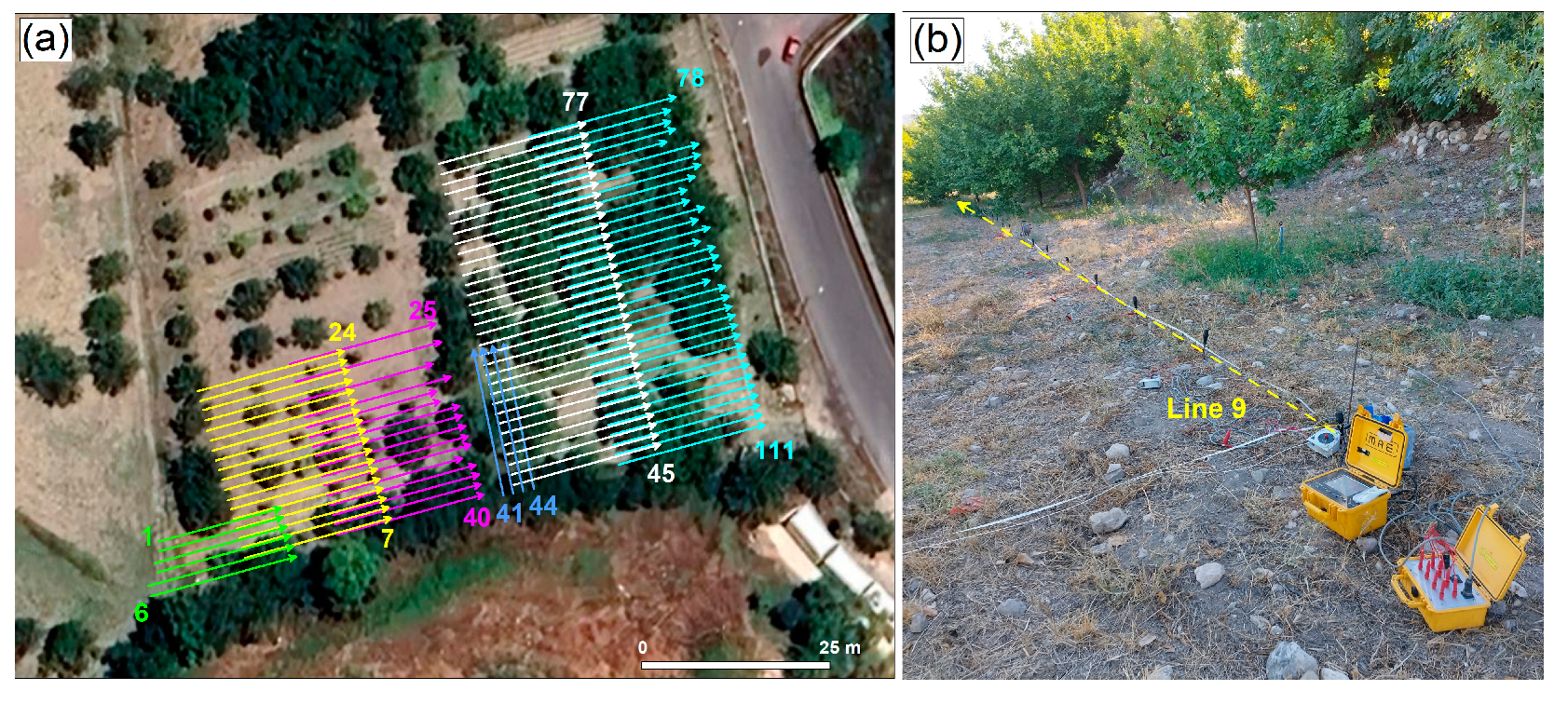
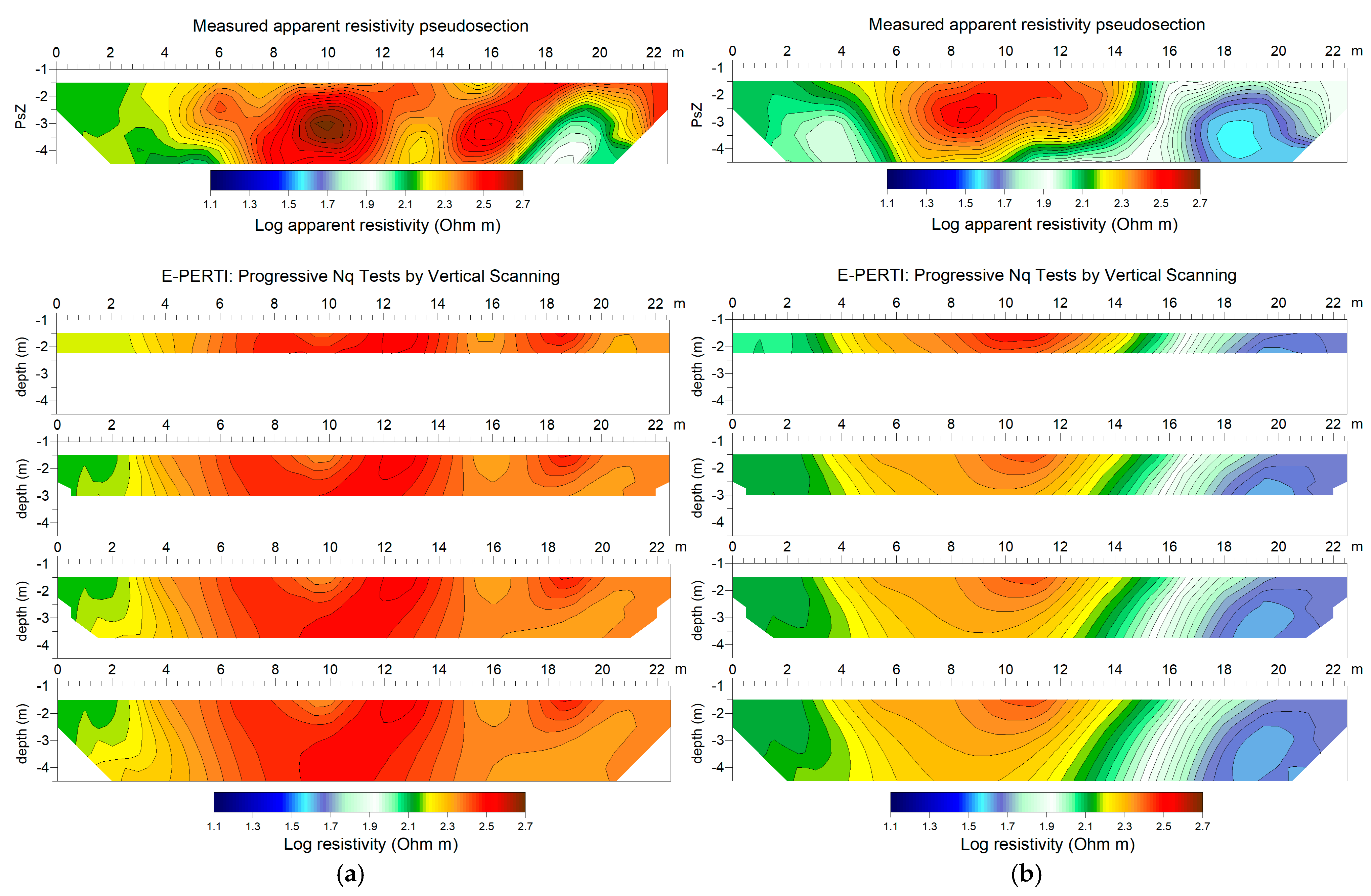
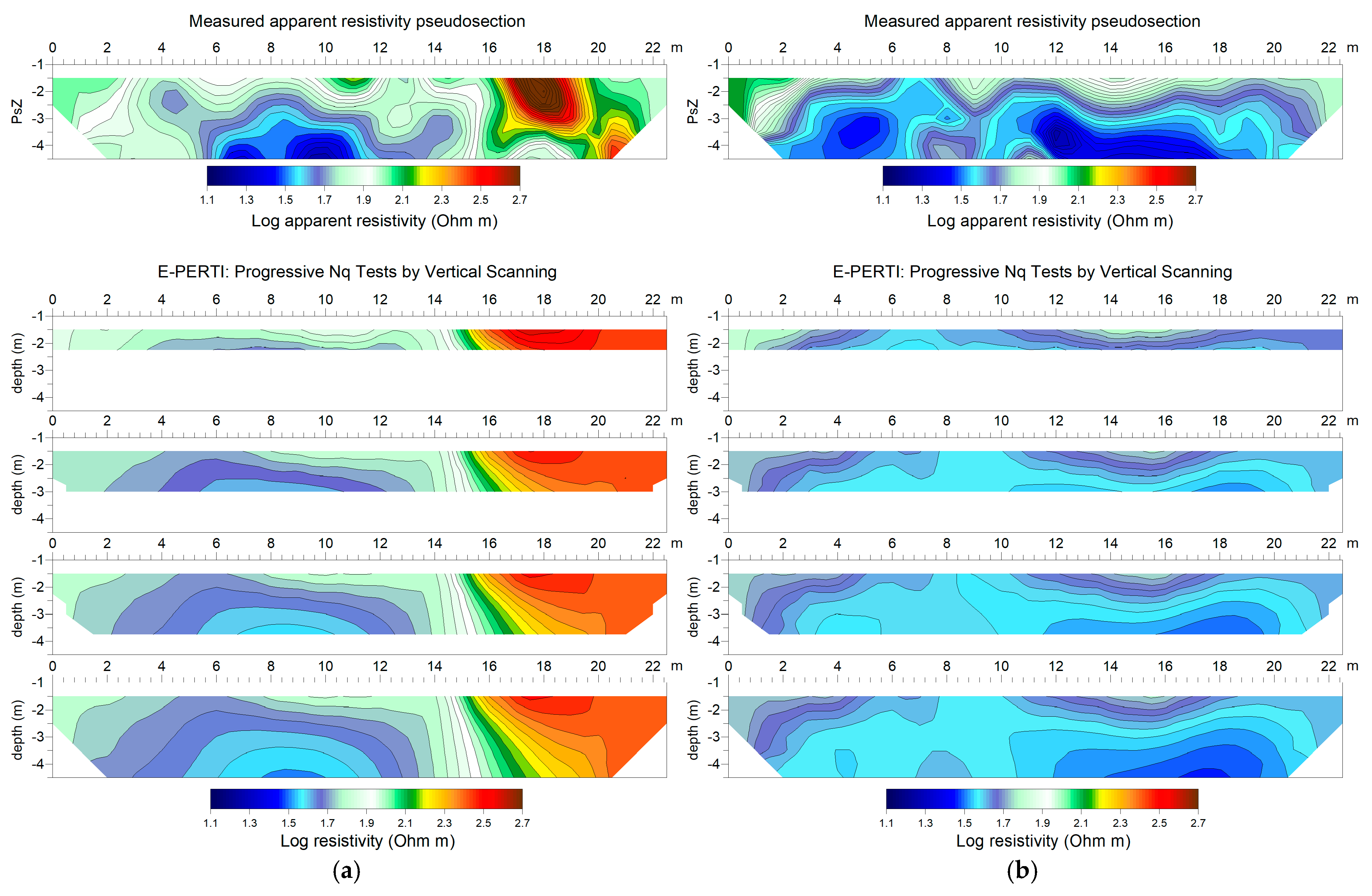

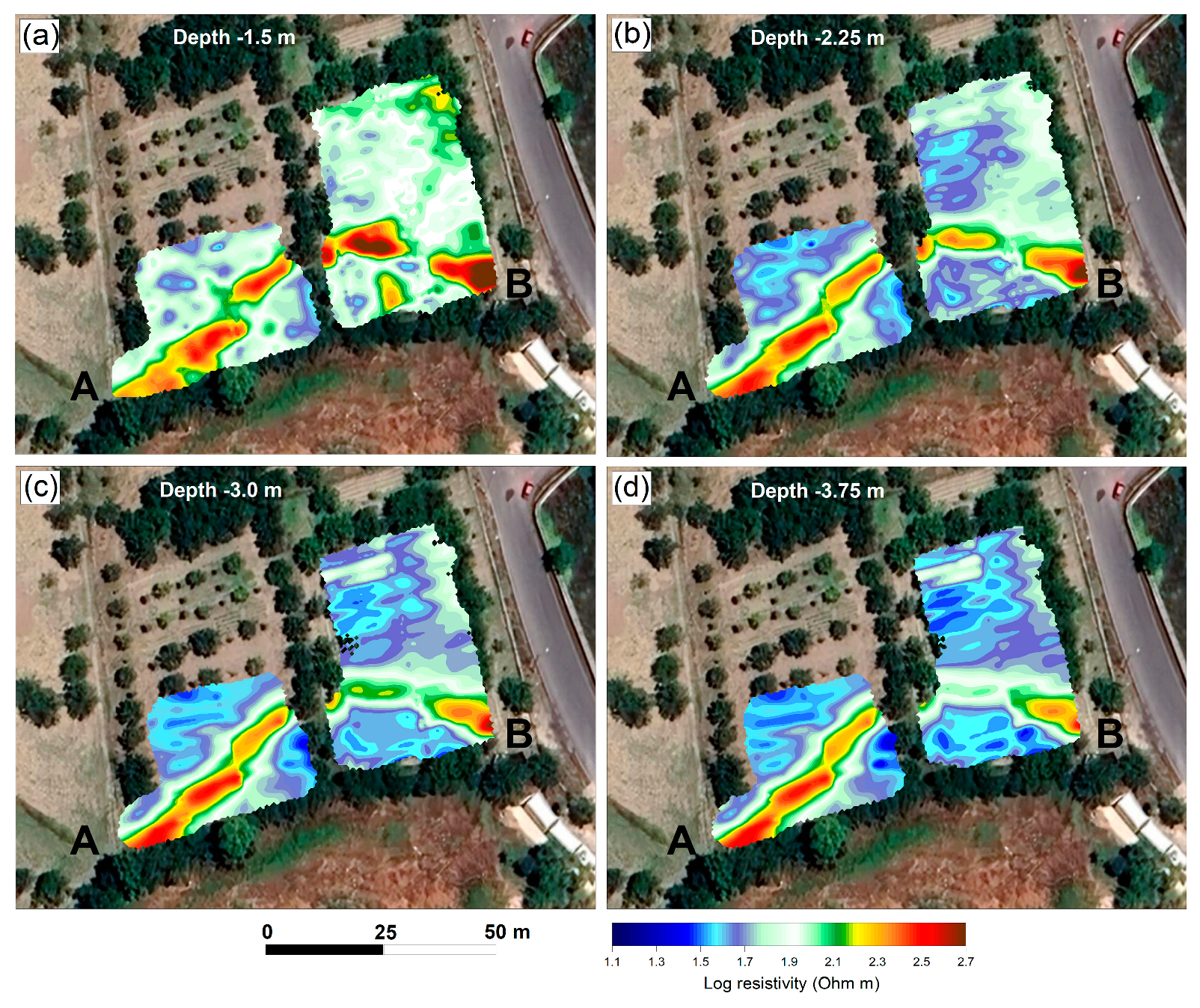

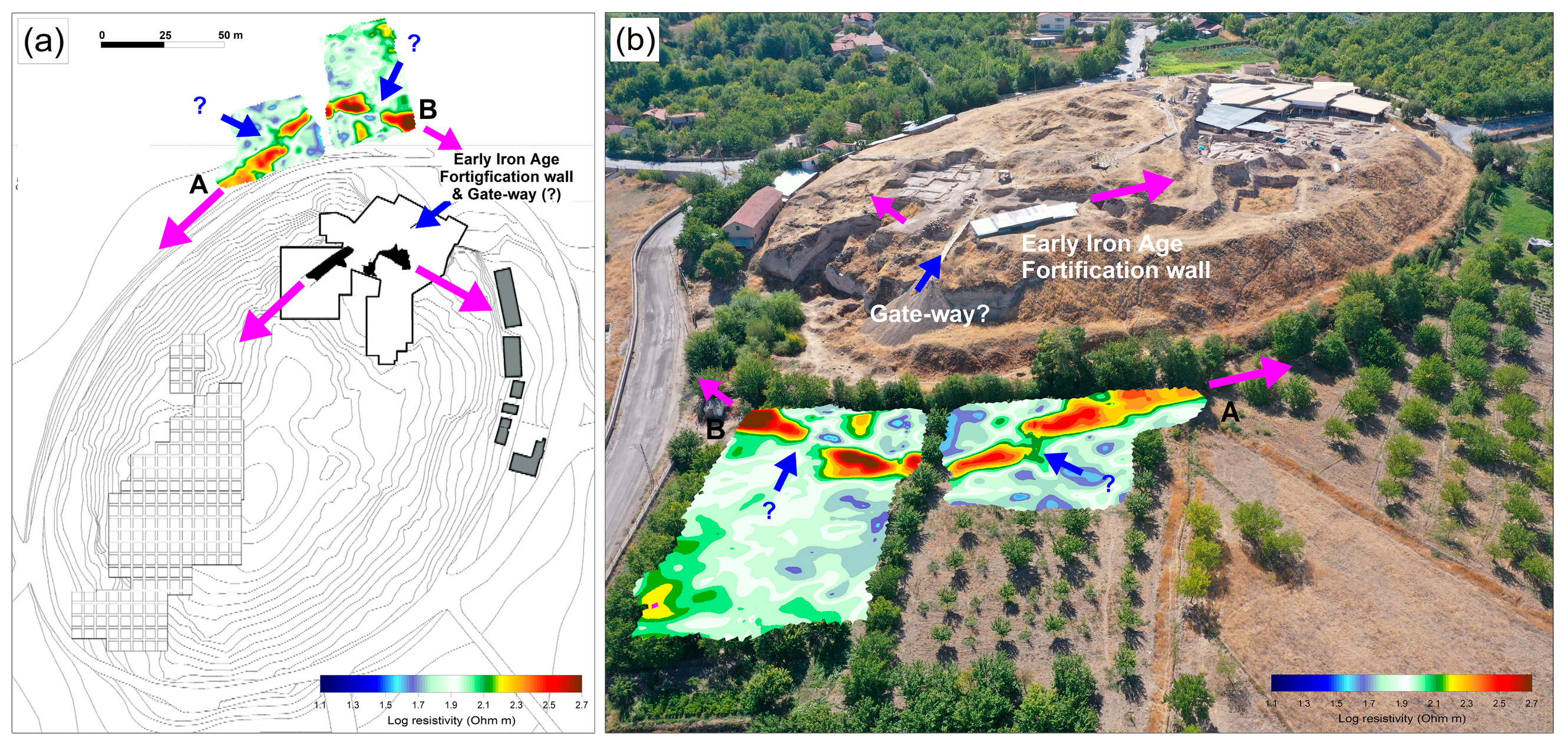

Disclaimer/Publisher’s Note: The statements, opinions and data contained in all publications are solely those of the individual author(s) and contributor(s) and not of MDPI and/or the editor(s). MDPI and/or the editor(s) disclaim responsibility for any injury to people or property resulting from any ideas, methods, instructions or products referred to in the content. |
© 2025 by the authors. Licensee MDPI, Basel, Switzerland. This article is an open access article distributed under the terms and conditions of the Creative Commons Attribution (CC BY) license (https://creativecommons.org/licenses/by/4.0/).
Share and Cite
Balossi Restelli, F.; Cozzolino, M.; Manuelli, F.; Mauriello, P. The Characterization of the Lower Town of the UNESCO Archaeological Site of Arslantepe (Malatya, Türkiye) Using the Geophysical E-PERTI Method (Extended Data-Adaptive Probability-Based Electrical Resistivity Tomography Inversion Method). Heritage 2025, 8, 37. https://doi.org/10.3390/heritage8020037
Balossi Restelli F, Cozzolino M, Manuelli F, Mauriello P. The Characterization of the Lower Town of the UNESCO Archaeological Site of Arslantepe (Malatya, Türkiye) Using the Geophysical E-PERTI Method (Extended Data-Adaptive Probability-Based Electrical Resistivity Tomography Inversion Method). Heritage. 2025; 8(2):37. https://doi.org/10.3390/heritage8020037
Chicago/Turabian StyleBalossi Restelli, Francesca, Marilena Cozzolino, Federico Manuelli, and Paolo Mauriello. 2025. "The Characterization of the Lower Town of the UNESCO Archaeological Site of Arslantepe (Malatya, Türkiye) Using the Geophysical E-PERTI Method (Extended Data-Adaptive Probability-Based Electrical Resistivity Tomography Inversion Method)" Heritage 8, no. 2: 37. https://doi.org/10.3390/heritage8020037
APA StyleBalossi Restelli, F., Cozzolino, M., Manuelli, F., & Mauriello, P. (2025). The Characterization of the Lower Town of the UNESCO Archaeological Site of Arslantepe (Malatya, Türkiye) Using the Geophysical E-PERTI Method (Extended Data-Adaptive Probability-Based Electrical Resistivity Tomography Inversion Method). Heritage, 8(2), 37. https://doi.org/10.3390/heritage8020037






